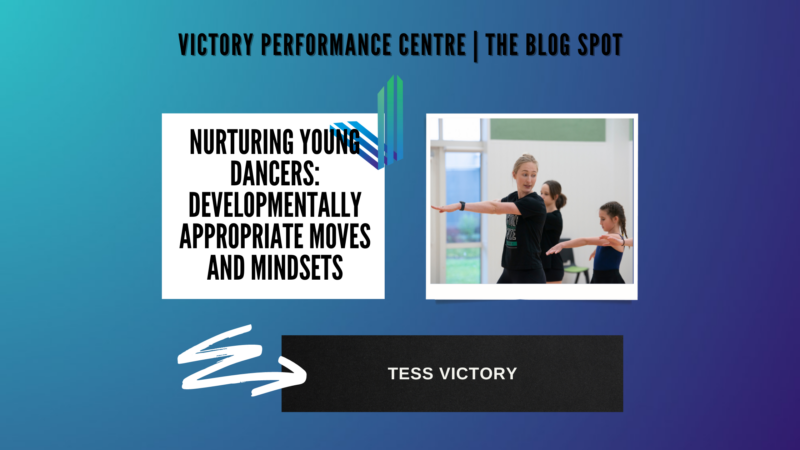Nurturing Young Dancers: Developmentally Appropriate Moves and Mindsets
Nurturing young dancers through developmentally appropriate moves, positive mindsets, and a lifelong love for movement.
Written by Tess Victory
Embark on a journey of nurturing young dancers
In this blog, we delve into the importance of nurturing young dancers with developmentally appropriate dance moves and mindsets. Sometimes in the excitement to do everything, dancers can’t want to jump ahead and learn more advanced dance moves and techniques. A classic example is children wanting to be ‘en pointe’ but not yet developed enough with the required skill level or strength.
As parents and dance teachers, we play a vital role in fostering a positive and nurturing environment for young dancers. In this blog, we will delve into the importance of positive talk, appropriate music and moves for their age, avoiding the sexualisation of kids through clothing, and the potential risks of overstretching and overtraining. Drawing on the expertise of renowned dance educator Lisa Howell, a respected figure in the dance community, we’ll explore ways to support our children’s dance development while preserving their younger childhood years.
Positive talk: Encouraging a healthy mindset
When it comes to dance training, our words tremendously impact our child’s self-esteem and confidence. Lisa Howell reminds us to encourage and praise your child’s efforts rather than focusing solely on their achievements. Explain that progress comes with time and dedication. We love the quote: “You can borrow my belief in you until you can find yours, ” emphasising the power of positive talk.
By cultivating a supportive and uplifting atmosphere, we’re empowering our young dancers to flourish and embrace their unique journey without comparison with their peers or pressure from those they are closest to.
Appropriate music and moves for age: Respecting childhood innocence
While teaching at VPC, we take our responsibility to ensure that our children are exposed to age-appropriate music and choreography seriously. Lisa Howell stresses the significance of preserving childhood innocence in dance. This means avoiding songs with lyrics or routines that sexualise or objectify young dancers.
Instead, we seek out music with ‘clean’ lyrics and moves that allow children to express themselves artistically and joyfully. As dance teachers, we spend time ensuring the selection of music and dance moves aligns with each dance age group’s developmental stage and values.
Dressing kids for dance: Comfort and modesty
Choosing the right dance attire is vital to your child’s comfort, confidence, and safety. That’s why at VPC, we advocate for clothing that promotes modesty. In our studio, we choose competition costumes and dancewear, which promote freedom of movement while ensuring appropriate coverage.
Comfortable and well-fitted outfits enhance performance and help young dancers focus on their technique and expression without distractions. Let’s also remember that every dancer has their unique style and preferences regarding costumes, and it’s important to respect and support each child and family’s preference while keeping their well-being in mind.
Overstretching: Understanding healthy boundaries
While flexibility is essential to dance, overstretching can harm young dancers’ developing bodies. We are cautious against pushing children beyond their limits, which can lead to injuries and long-term damage. Instead, we encourage children to engage in a proper and fun warm-up routine and ensure they stretch mindfully under the guidance of qualified dance teachers. We teach an understanding that progress in flexibility should be gradual and safe rather than pursuing extreme ranges of motion at the expense of well-being.
Overtraining: Balancing commitment and well-being
In our eagerness to support our child’s passion for dance, we must also be mindful of the risks associated with overtraining. Lisa Howell highlights the importance of finding a balance between commitment and well-being. While dedication and hard work are commendable, excessive training can lead to physical and emotional burnout. Monitor your child’s training schedule and ensure they have adequate rest and recovery time. Encourage them to pursue a well-rounded lifestyle, including socialising, hobbies, self-care and quiet downtime.
Conclusion
By prioritising developmentally appropriate dance moves and nurturing mindsets, we can provide our young dancers with an environment that supports their growth, creativity, and well-being. Positive talk, music with appropriate lyrics and choreography, modest dancewear, and setting boundaries with stretching and training are important. Remember, dance should be a joyful journey for your children, allowing them to express themselves, build confidence, and discover their own unique artistry. It’s worth noting that while only a small percentage of children pursue dance professionally, the benefits of a good relationship with movement extend far beyond childhood and teenage years.
So let’s guide them with love, encouragement, and a deep understanding of what is best for their physical, emotional, and psychological development.
If you have any further questions or would like to explore dance, please reach out directly to Miss Tess – admin@victoryperformancecentre.com


